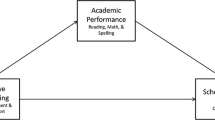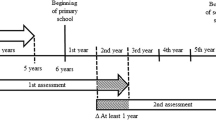Abstract
Purpose
Effects of tumor location on cognitive performance of patients with brain tumor are controversial: some studies reported higher risks related to supratentorial locations, some to infratentorial locations, and still others did not find any differences. We aimed to address this issue by comparing school-aged children with supratentorial or infratentorial tumor with respect not only to cognitive outcomes but also to the associations between core cognitive domains and academic abilities.
Methods
32 children with infratentorial tumor and 22 with supratentorial tumor participated in the study. To detect relationships among cognitive domains, we tested which neuropsychological variable(s) predicted academic skills, controlling for the effects of radiotherapy and time since diagnosis.
Results
Radiotherapy and time since diagnosis, but not tumor location, predicted cognitive outcomes. Radiotherapy negatively influenced attention and executive functioning, as well as reading speed and arithmetic operations accuracy. Unexpectedly, longer time since diagnosis was associated with improvement in attention and reading speed. Tumor location showed an effect on the relationships between core cognitive domains and academic skills: verbal and visual-spatial memory influenced reading and mathematical performance in supratentorial patients; in infratentorial patients, an only effect of visual-spatial memory on mathematical performance was detected.
Conclusions
Tumor location seems not to influence cognitive performance, while radiotherapy constitutes a key risk factor for cognitive impairment. Attentional and reading abilities may improve over time, possibly due to the weakening of cancer care effects. Different patterns of cognitive associations seem to characterize supratentorial and infratentorial patients, probably associated with different neuroplastic reorganization processes after tumor occurrence.
Similar content being viewed by others
References
Glauser TA, Packer RJ (1991) Cognitive deficits in long-term survivors of childhood brain tumors. Childs Nerv Syst 7:2–12. https://doi.org/10.1007/bf00263824
Gragert MN, Ris MD (2011) Neuropsychological late effects and rehabilitation following pediatric brain tumor. J Pediatr Rehabil Med 4(1):47–58. https://doi.org/10.3233/PRM-2011-0153
Kuehni CE, Strippoli MP, Rueegg CS, Rebholz CE, Bergstraesser E, Grotzer M, von der Weid NX, Michel G (2012) Educational achievement in Swiss childhood cancer survivors compared with the general population. Cancer 118:1439–1449. https://doi.org/10.1002/cncr.26418
Robinson KE, Kuttesch JF, Champion JE, Andreotti CF, Hipp DW, Bettis A, Barnwell A, Compas BE (2010) A quantitative meta-analysis of neurocognitive sequelae in survivors of pediatric brain tumors. Pediatr Blood Cancer 55:525–531. https://doi.org/10.1002/pbc.22568
Palmer SL, Goloubeva O, Reddick WE, Glass JO, Gajjar A, Kun L, Merchant TE, Mulhern RK (2001) Patterns of intellectual development among survivors of pediatric medulloblastoma: a longitudinal analysis. J Clin Oncol 19(8):2302–2308. https://doi.org/10.1200/JCO.2001.19.8.2302
Turner CD, Rey-Casserly C, Liptak CC, Chordas C (2009) Late effects of therapy for pediatric brain tumor survivors. J Child Neurol 24(11):1455–1463. https://doi.org/10.1177/0883073809341709
Duffner PK (2010) Risk factors for cognitive decline in children treated for brain tumors. Eur J Paediatr Neurol 14(2):106–115. https://doi.org/10.1016/j.ejpn.2009.10.005
Hardy KK, Bonner MJ, Willard VW, Watral MA, Gururangan S (2008) Hydrocephalus as a possible additional contributor to cognitive outcome in survivors of pediatric medulloblastoma. Psychooncol 17:1157–1161. https://doi.org/10.1002/pon.1349
Kieffer-Renaux V, Viguier D, Raquin MA, Laurent-Vannier A, Habrand JL, Dellatolas G, Kalifa C, Hartmann O, Grill J (2005) Therapeutic schedules influence the pattern of intellectual decline after irradiation of posterior fossa tumors. Pediatr Blood Cancer 45:814–819. https://doi.org/10.1002/pbc.20329
Poggi G, Liscio M, Galbiati S, Adduci A, Massimino M, Gandola L, Spreafico F, Clerici CA, Fossati-Bellani F, Sommovigo M, Castelli E (2005) Brain tumors in children and adolescents: cognitive and psychological disorders at different ages. Psychooncol 14(5):386–395. https://doi.org/10.1002/pon.855
Stargatt R, Rosenfeld JV, Maixner W, Ashley D (2007) Multiple factors contribute to neuropsychological outcome in children with posterior fossa tumors. Dev Neuropsychol 32:729–748
Ullrich NJ, Embry L (2012) Neurocognitive dysfunction in survivors of childhood brain tumors. Semin Pediatr Neurol 19(1):35–42. https://doi.org/10.1016/j.spen.2012.02.014
Mabbott DJ, Spiegler BJ, Greenberg ML, Rutka JT, Hyder DJ, Bouffet E (2005) Serial evaluation of academic and behavioral outcome after treatment with cranial radiation in childhood. J Clin Oncol 23(10):2256–2263. https://doi.org/10.1200/JCO.2005.01.158
Rodgers SP, Trevino M, Zawaski JA, Gaber MW, Leasure JL (2013) Neurogenesis, exercise, and cognitive late effects of pediatric radiotherapy. Neural Plast 2013:698528. https://doi.org/10.1155/2013/698528
Spiegler BJ, Bouffet E, Greenberg ML, Rutka JT, Mabbott DJ (2004) Change in neurocognitive functioning after treatment with cranial radiation in childhood. J Clin Oncol 22:706–713. https://doi.org/10.1200/JCO.2004.05.186
Steen RG, Koury BSM, Granja CI, Xiong X, Wu S, Glass JO, Mulhern RK, Kun LE, Merchant TE (2001) Effect of ionizing radiation on the human brain: white matter and gray matter T1 in pediatric brain tumor patients treated with conformal radiation therapy. Int J Radiat Oncol Biol Phys 49(1):79–91. https://doi.org/10.1016/S0360-3016(00)01351-1
Packer RJ, Vezina G (2008) Management of and prognosis with medulloblastoma: therapy at a crossroads. Arch Neurol 65(11):1419–1424. https://doi.org/10.1001/archneur.65.11.1419
Patel SK, Mullins WA, O’Neil SH, Wilson K (2011) Neuropsychological differences between survivors of supratentorial and infratentorial brain tumours. J Intellect Disabil Res 55(1):30–40. https://doi.org/10.1111/j.1365-2788.2010.01344.x
Aarsen FK, Paquier PF, Reddingius RE, Streng IC, Arts WF, Evera-Preesman M, Catsman-Berrevoets CE (2006) Functional outcome after low-grade astrocytoma treatment in childhood. Cancer 106:396–402. https://doi.org/10.1002/cncr.21612
Iuvone L, Peruzzi L, Colosimo C, Tamburrini G, Caldarelli M, Di Rocco C, Battaglia D, Guzzetta F, Misciagna S, Di Giannatale A, Ruggiero A, Riccardi R (2011) Pretreatment neuropsychological deficits in children with brain tumors. Neuro-Oncology 13(5):517–524. https://doi.org/10.1093/neuonc/nor013
Lannering B, Marky I, Lundberg A, Olsson E (1990) Long-term sequelae after pediatric brain tumors: their effect on disability and quality of life. Med Pediatr Oncol 18:304–310. https://doi.org/10.1002/mpo.2950180410
Reimers TS, Ehrenfels S, Mortensen EL, Schmiegelow M, Sønderkaer S, Carstensen H, Schmiegelow K, Müller J (2003) Cognitive deficits in long-term survivors of childhood brain tumors: identification of predictive factors. Med Pediatr Oncol 40(1):26–34
Stargatt R, Rosenfeld JV, Anderson V, Hassall T, Maixner W, Ashley D (2006) Intelligence and adaptive function in children diagnosed with brain tumor during infancy. J Neuro-Oncol 80:295–303
King TZ, Fennell EB, Williams L, Algina J, Boggs S, Crosson B, Leonard C (2004) Verbal memory abilities of children with brain tumors. Child Neuropsychol 10:76–88. https://doi.org/10.1080/09297040490911096
Micklewright JL, King TZ, Morris RD, Morris MK (2007) Attention and memory in children with brain tumors. Child Neuropsychol 13:522–527. https://doi.org/10.1080/09297040601064487
Shortman RI, Lowis SP, Penn A, McCarter RJ, Hunt LP, Brown CC, Stevens MC, Curran AL, Sharples PM (2014) Cognitive function in children with brain tumors in the first year after diagnosis compared to healthy matched controls. Pediatr Blood Cancer 61(3):464–472. https://doi.org/10.1002/pbc.24746
Carpentieri SC, Waber D, Pomeroy SL, Scott RM, Goumnerova LC, Kieran MW, Billett AL, Tarbell NJ (2003) Neuropsychological functioning after surgery in children treated for brain tumor. Neurosurgery 5:1348–1357. https://doi.org/10.1227/01.NEU.0000064804.00766.62
Jannoun L, Bloom HJ (1990) Long-term psychological effects in children treated for intracranial tumors. Int J Radiat Oncol Biol Phys 18(4):747–753
Upton P, Eiser C (2006) School experiences after treatment for a brain tumor. Child Care Health Dev 32:9–17. https://doi.org/10.1111/j.1365-2214.2006.00569.x
Wechsler D (2006) Wechsler intelligent scale for children – third edition (WISC-III). Italian Translation. Organizzazioni Speciali, Firenze (original work published 1991)
Wechsler D (2012) Wechsler intelligent scale for children – fourth edition (WISC-IV). Italian Translation. Organizzazioni Speciali, Firenze (original work published 2003)
Bisiacchi PS, Cendron M, Gugliotta M, Tressoldi PE, Vio C (2005) BVN 5-11 - Batteria di valutazione neuropsicologica per l'età evolutiva. [Battery for neuropsychological evaluation for developmental age]. Erickson, Trento
Gugliotta M, Bisiacchi PS, Cendron M, Tressoldi PE, Vio C (2009) BVN 12-18. Batteria di Valutazione Neuropsicologica per l'adolescenza. [BVN 12-18. Battery of neuropsychological evaluation for adolescence]. Erickson, Trento
Grant DA, Berg EA (1993) Wisconsin Card Sorting Test. Psychological Assessment Resources, Odessa
Rey A (1979) Reattivo di memoria - figura complessa. [Rey-Osterrieth Complex Figure Memory Test]. Italian Translation. Organizzazioni Speciali, Firenze (original work published 1944)
Cornoldi C, Colpo G (1995) Nuove Prove di lettura MT per la Scuola Secondaria di I Grado. [New MT reading tasks for the 1st grade of secondary school]. Organizzazioni Speciali, Firenze
Cornoldi C, Colpo G (1998) Prove di lettura MT-2 per la scuola primaria. [MT-2 reading tasks for primary school]. Organizzazioni Speciali, Firenze
Cornoldi C, Pra Baldi A, Friso G (2010) MT Avanzate – 2. Prove MT Avanzate di Lettura e Matematica 2 per il biennio della scuola superiore di II grado. [Advanced MT – 2. Advanced MT reading and mathematical tasks for the second grade of secondary school]. Organizzazioni Speciali, Firenze
Cornoldi C, Cazzola C (2003) AC-MT 11-14. Test di valutazione delle abilità di calcolo e problem-solving dagli 11 ai 14 anni. [AC-MT 11-14. Test for evaluating arithmetic and problem-solving abilities]. Erickson, Trento
Cornoldi C, Lucangeli D, Bellina M (2002) Test AC-MT 6-11 - Test di valutazione delle abilità di calcolo. [AC-MT 6-11 test – Test for evaluating calculation abilities]. Gruppo MT. Erickson, Trento
Araujo GC, Antonini TN, Anderson V, Vannatta KA, Salley CG, Bigler ED, Taylor HG, Gerhardt C, Rubin K, Dennis M, Lo W, Mackay MT, Gordon A, Hajek Koterba C, Gomes A, Greenham M, Owen Yeates K (2017) Profiles of executive function across children with distinct brain disorders: traumatic brain injury, stroke, and brain tumor. J Int Neuropsychol Soc 15:1–10. https://doi.org/10.1017/S1355617717000364
Schatz J, Kramer JH, Ablin A, Matthay KK (2000) Processing speed, working memory, and IQ: a developmental model of cognitive deficits following cranial radiation therapy. Neuropsychol 14:189–200. https://doi.org/10.1037/0894-4105.14.2.189
Vaquero E, Gómez CM, Quintero EA, González-Rosa JJ, Márquez J (2008) Differential prefrontal-like deficit in children after cerebellar astrocytoma and medulloblastoma tumor. Behav Brain Funct 4:18. https://doi.org/10.1186/1744-9081-4-18
Geary DC, Hoard MK, Nugent L, Byrd-Craven J (2008) Development of number line representations in children with mathematical learning disability. Dev Neuropsychol 33:277–299. https://doi.org/10.1080/87565640801982361
Zorzi M, Priftis K, Umiltá C (2002) Neglect disrupts the mental number line. Nature 417(6885):138–139
Dupont S, Samson Y, Le Bihan D, Baulac M (2002 Feb) (2002). Anatomy of verbal memory: a functional MRI study. Surg Radiol Anat 24(1):57–63. https://doi.org/10.1007/s00276-002-0005-x
Richardson MP, Strange BA, Duncan JS, Dolan RJ (2003) Preserved verbal memory function in left medial temporal pathology involves reorganisation of function to right medial temporal lobe. Neuroimage 20(Suppl 1):S112–S119. https://doi.org/10.1016/j.neuroimage.2003.09.008
Margelisch K, Studer M, Ritter BC, Steinlin M, Leibundgut K, Heinks T (2015) Cognitive dysfunction in children with brain tumors at diagnosis. Pediatr Blood Cancer 62(10):1805–1812. https://doi.org/10.1002/pbc.25596
Nagy Z, Westerberg H, Klingberg T (2004) Maturation of white matter is associated with the development of cognitive functions during childhood. J Cogn Neurosci 16(7):1227–1233. https://doi.org/10.1162/0898929041920441
Steinlin M, Roellin K, Schroth G (2004) Long-term follow-up after stroke in childhood. Eur J Pediatr 163(4–5):245–250. https://doi.org/10.1007/s00431-003-1357-x
Brière ME, Scott JG, McNall-Knapp RY, Adams RL (2008) Cognitive outcome in pediatric brain tumor survivors: delayed attention deficit at long-term follow-up. Pediatr Blood Cancer 50(2):337–340. https://doi.org/10.1002/pbc.21223
Funding
This work was supported by Scientific Institute, IRCCS E. Medea, Bosisio Parini, Lecco Italy (Progetto di Ricerca 5x1000, #111) and by the Italian Ministry of Health (Ricerca Corrente 2019).
Author information
Authors and Affiliations
Corresponding author
Ethics declarations
Conflict of interest
The authors declare that they have no conflict of interest.
Ethical approval
All procedures performed in this study were in accordance with the ethical standards of the institutional research committee and with the 1964 Helsinki declaration and its later amendments or comparable ethical standards.
Informed consent
In our Scientific Institute, at the moment of the clinical evaluation of children, parents are proposed to sign an informed consent to allow data treatment for research. Informed consent was obtained from all parents of individual participants included in the study.
Additional information
Publisher’s note
Springer Nature remains neutral with regard to jurisdictional claims in published maps and institutional affiliations.
Electronic supplementary material
ESM 1
(DOCX 29 kb)
Rights and permissions
About this article
Cite this article
Corti, C., Urgesi, C., Massimino, M. et al. Effects of supratentorial and infratentorial tumor location on cognitive functioning of children with brain tumor. Childs Nerv Syst 36, 513–524 (2020). https://doi.org/10.1007/s00381-019-04434-3
Received:
Accepted:
Published:
Issue Date:
DOI: https://doi.org/10.1007/s00381-019-04434-3




